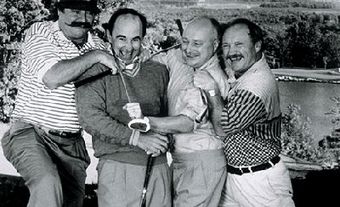Parachuting is a sport, also known as skydiving. The earliest jumps were made from balloons, and the first successful parachute descent was performed in 1797 over Paris. Free-falling jumps were not possible until 1908, when the ripcord was devised, though the ripcord was not used from an airplane until 1912. Contests began in the US in 1926, and the first world championship was held in Yugoslavia in 1951. Competitors normally use light aircraft to carry them to about 3600 m, and parachutes are usually opened at about 760 m. Sport parachutists compete in 4 world championship areas: free-fall individual style manoeuvres, combined with precision accuracy landing; 4- and 8-person group free-fall competition, with recreational jumping in groups of 2 to 100; "open parachute" formations, called canopy relative work; and "para-ski," combining precision accuracy with giant slalom skiing. In 1988, a 144-way was built in the US, setting a new world record for largest formation.
The first parachute jump in Canada was made in 1912, by an American, in Vancouver. In 1919, Frank Ellis became the first Canadian to jump in Canada, when he descended from a Jenny aircraft over Lake Erie; the Frank Ellis Trophy commemorates this event. After WWII, clubs and competitions were organized in Canada. The oldest surviving club is the St Catharines Parachuting Club, formed in 1948. The Parachute Club of Canada was formed in 1956, for the control and advancement of Canadian sport parachuting; this club merged with the Western Canada Parachute Club in 1962, and in 1967 it was re-named the Canadian Sport Parachuting Association. In 1967, the CSPA initiated a system to train instructors.
The Canadian National Parachuting Team has ranked among the top 10 countries in international competition since 1960. S.F. Wykeham-Martin became the first Canadian to win a medal in world competition, placing 2nd in individual accuracy in 1966; in that same year, the Canadian men's team placed 2nd in the group precision event, and 3rd overall at the World Championships. In 1976 Pierre Forand won the silver medal in the men's absolute overall category, missing the world championship by 1/500th of a second. Canadian teams dominated parachuting in the late 1970s, winning the world overall relative-work (2 or more parachutists maneuvering together during free-fall) championships in 1977 and 1979. They placed 2nd overall in 1981, and won gold (8-way) in 1983 and 1984, silver (8-way) in 1984 and silver (4-way) and bronze (8-way) in 1985. In 1990 and 1994, the Canadian team placed 3rd in CF Rotation, and, in 1998, 3rd in CF Sequential. In 1996, 50 people established the largest Canadian freefall formation, and in 1998, 18 created the largest canopy formation.
Canadian women have also performed well in international jumping competitions. In 1970, Carol Brand became the first Canadian female parachutist to win a medal in world competition, when she placed 3rd overall. Kathy Cox won the women's world accuracy championship in 1980, and in 1984 was awarded the Order of Canada for her achievements in parachuting. The Canadian women's team won the silver medal in team accuracy at the 1982 world championships. In 1987 Bev Watson won the World Para-ski Overall competition, and in 1988 Lisa Olsen won the World Individual Accuracy event.
Five licences of proficiency are awarded, and competition jumping (in both 4- and 8-person teams) is also organized by the CSPA. The G.R. Masterson Trophy is the premier parachuting award in Canada.

 Share on Facebook
Share on Facebook Share on X
Share on X Share by Email
Share by Email Share on Google Classroom
Share on Google Classroom


